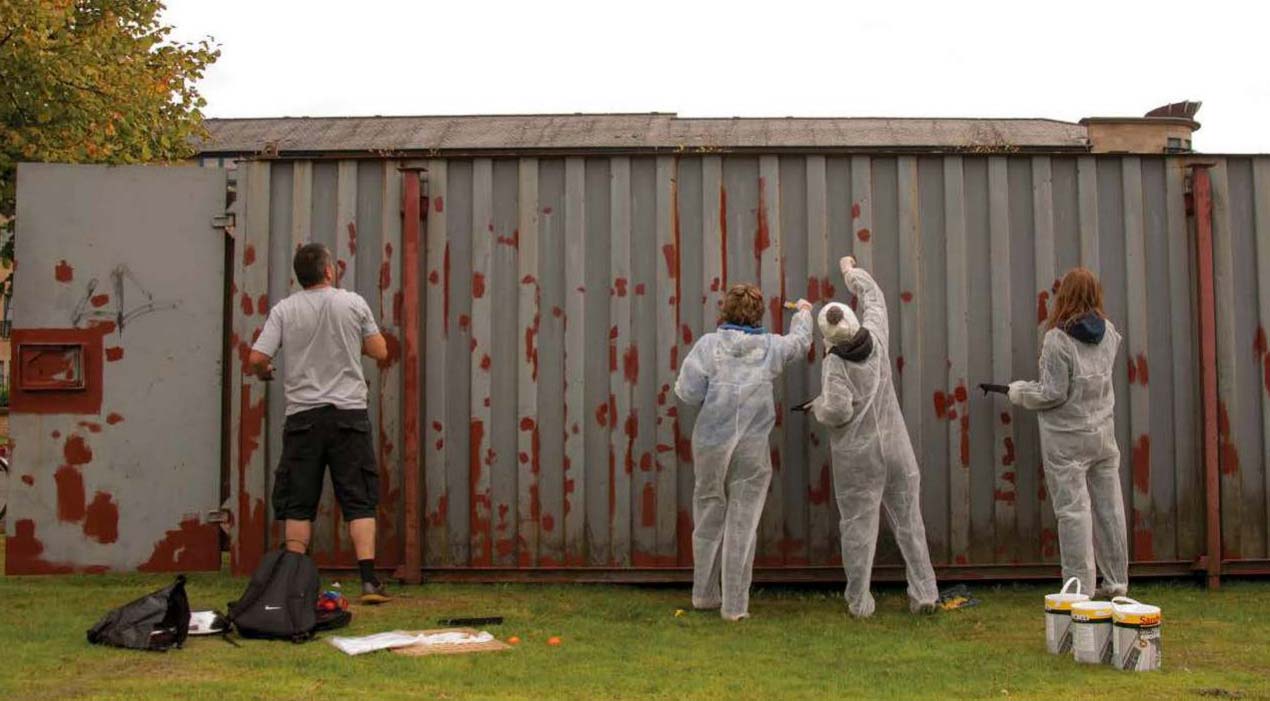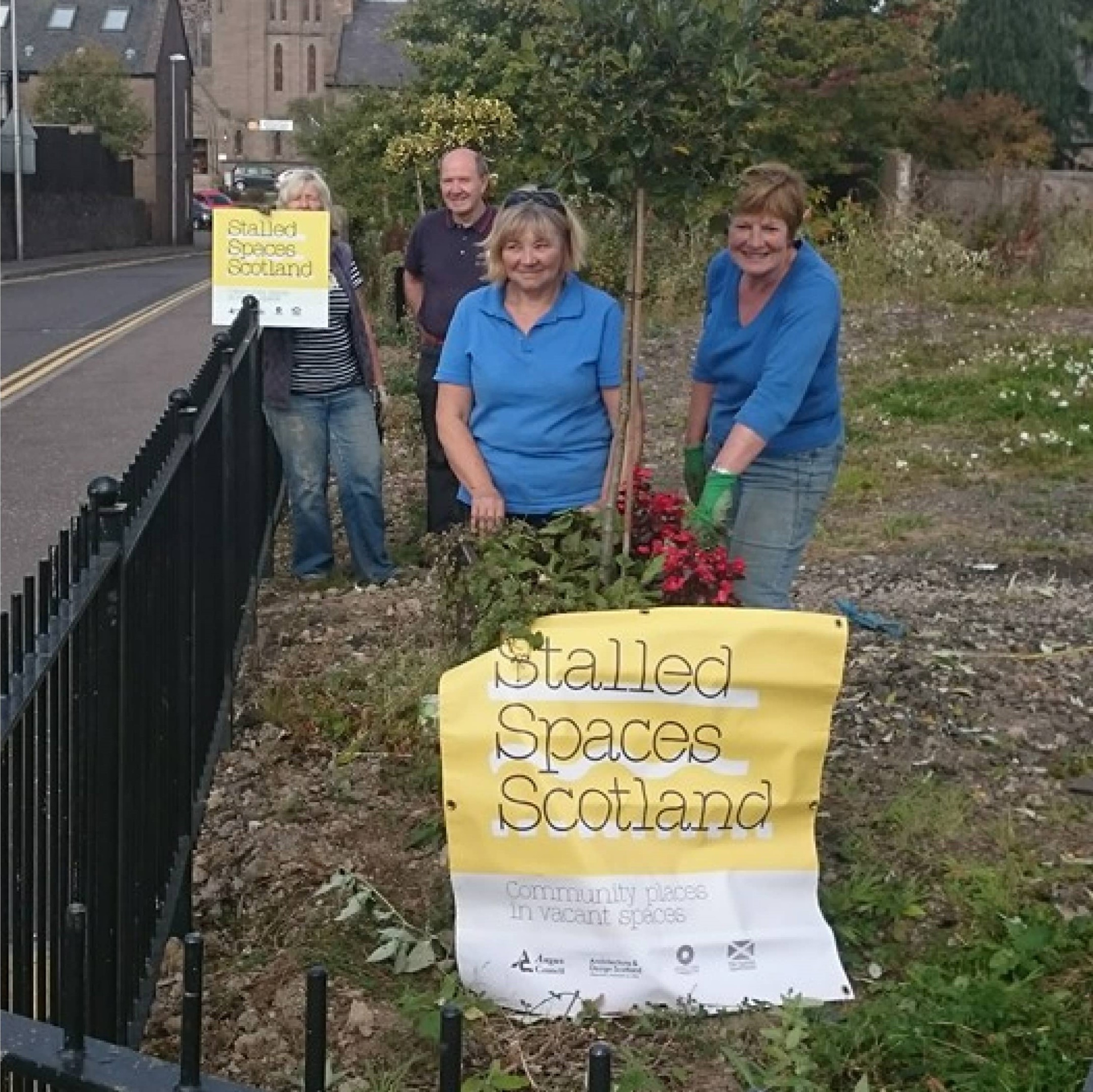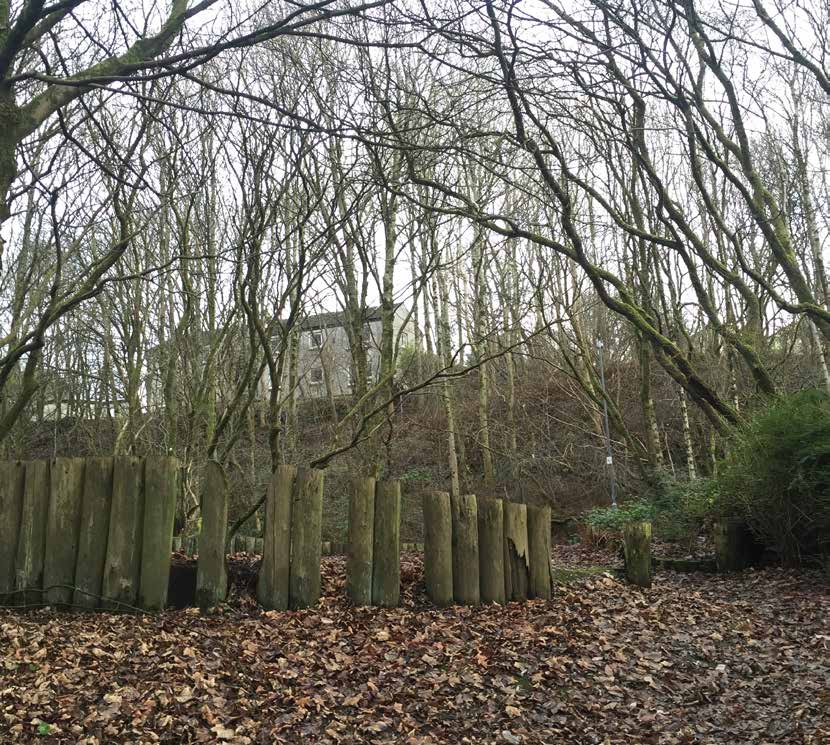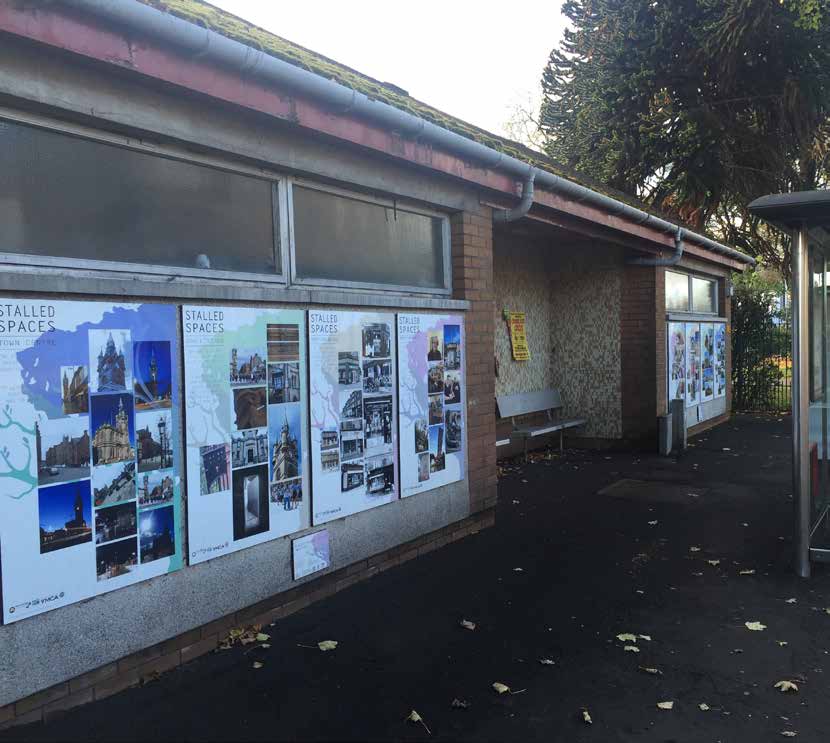Stalled Spaces Scotland
Featuring a comprehensive guide and real-life examples of success stories from Stalled Spaces Scotland projects.

Stalled Spaces Scotland was a Legacy 2014 programme commissioned by the Scottish Government and delivered by Architecture and Design Scotland (A&DS) to facilitate the temporary use of under-used green spaces, stalled development sites or vacant and derelict land in town centres throughout Scotland.
Aligning with the Scottish Government’s ‘Town Centre Action Plan’ and the ‘Town Centre First Principle’, the programme looked at stalled spaces located within town centres—empowering people to bring these spaces back into positive use for the benefit of the whole community.
(Please note that the national programme is no longer running. However, you can find out more on the original programme at Glasgow.gov.uk )
Supporting seven local authorities in Scotland
Through this programme we supported seven local authorities to develop their own initiatives, using the knowledge and learning from the award-winning Stalled Spaces initiative developed by Glasgow City Council. The seven local authorities were:
- Angus
- East Dunbartonshire
- East Renfreshire
- North Ayshire
- Arygll & Brute
- Fife
- Renfrewshire
What this programme aimed to achieve
Through this programme we aimed to inspire and support organisations and local authorities to make use of underutilised places and spaces. We aimed to:
- encourage and support local authorities and related organisations across Scotland to deliver a stalled space initiative in their area
- enable communities to transform disused spaces and communicate their aspirations to local authorities in their development
- create a learning resource through community involvement.
- ensure there is legacy from the skills developed
- increase skill sharing and provide opportunities for knowledge exchange with both local communities and professionals
What can you do on a stalled space?
If you’re looking for some ideas and inspiration on starting a stalled space, you can consider the following:
- Community garden
- Natural play area
- Pop-up cinema
- Public art
- Rain garden
- Sensory garden
- Wild flower garden
- Wildlife garden
How to get your stalled space project up and running
We’ve added short descriptions of each individual aspect of what you need to do to get this project up and running. For more detailed information, you can download the Stalled Spaces toolkit.
A constituted group is a community group or organisation with a written document—a constitution—that describes what the group’s going to do and how they’ll do it. You need to create a constituted group for the following reasons:
- To set up a bank account
- To qualify for most funding
- To create a common understanding of the rules and structure of the group, scope, what is expected of everyone
- For future considerations your group and potential ongoing maintenance of the space
There are lots of ways to raise funds such as applying for a grant, crowdfunding, community shares or fundraising. You can find more information on different ways to secure funding by researching online or at your local library.
Whatever way you decide to raise funding for your project, you’ll need to create a project plan to showcase what you’re aiming to achieve and how to do it.
A project plan is a vital tool to secure funding. Here’s what you should include:
- Objective of your project – why you’re doing it and proof of need
- Timeline – a calendar to showcase your proposed activities
- Basic budget – costs involved in your planned activities
- Staffing needs – examples of support you’ll need to deliver project activities
- Resources – an outline of what you already have and what you need (e.g., funding, space, equipment, materials, etc.)
- Link-ups – external agencies, communities, or individuals you’ll need to liaise with (e.g., local authority or council, health bodies, charities, etc.)
- Impact – the difference(s) a grant would make and who would benefit
- Exit strategy – an outline of what you will do at the end of the project
Good financial management is a must if you want your stalled space project to succeed. Even if it’s just a small initiative, writing a budget should be one of your group’s first priorities. A budget can help you:
- understand (in monetary terms) what your group is going to do
- estimate how much your project will cost
- identify the funding you need to raise
- avoid unexpected costs
- keep track of payments
- make financial decisions
Your budget is an internal document for your group’s use. Funders or other external bodies won’t hold you to it.
You’ll need to find out who owns the stalled space you hope to make use of before going forward with your plans. Why do you need the landowner's permission?
- To obtain a lease agreement with owner
- To gain planning permission or other consents to use the land
- To identify ‘particular controls’ on the land (e.g., listed building or if the site is a site of specific interest)
- To receive funding post owner consent
As covered in the previous section, you MUST get written permission from the landowner before you begin any work on your stalled space site. This should take the form of a document that states exactly when your presence on the land will begin and end.
It doesn’t have to be complicated. It only needs to be a couple of pages long. First, however, you need to get the owner to agree to you using their land.
Think about the land from the owner’s perspective. What are their main needs, aims and concerns? If you know what these are and address them, you’ve got a much better chance of securing a lease with the landowner.
And don’t forget, only include items in your agreement that are relevant to your stalled spaces project and site.
You may need to secure planning permission even for a temporary use of a site. This will depend on the land’s current use, existing permissions and regulations, and the details of your specific project.
It’s important to know in the early stages of your project if you’re likely to need planning permission. This will enable you to factor in any related costs to your budget and start the application process as soon as possible.
Anything you build on the site will need to be cleared or removed when the time comes to vacate the space.
To reduce the likelihood of objections being made to your planning application, try to get local residents and relevant public bodies on board. Address any concerns BEFORE you apply. Typical concerns include traffic, parking, building location and how the site will look.
Even voluntary groups have to comply with insurance regulations so it’s vital that you have adequate coverage to protect your organisation’s money, people, property and its reputation.
There are many types of insurance, but they won’t all be necessary for your group. You have to decide what you’ll need based on your group’s aims and objectives, and the activities you’ll undertake to achieve them.
Make enquiries into what insurance cover you’ll need while you’re negotiating the lease. This will give you time to consider the risks and whether the landowner or the tenant will need to take out the policy.
Find out what insurance the landowner has, as this might cover your activity.
There are various risks that community groups of any size can face—from health and safety issues to losing funding sources. Sensible risk management can help you deliver your project even when there are bumps in the road.
Risk management is identifying, assessing and controlling situations where things could go wrong. For the most part, it just involves using common sense.
Known risks can be listed in a risk assessment document, alongside details on how you plan to manage (or avoid) them.
You don’t have to eliminate risks. You just need to reduce the risk to a level that your group is comfortable with. The key is to strike a balance between the level of risk while still being able to get on with the activity.
Volunteers are the lifeblood of community group initiatives. Whether they provide an extra pair of hands or valuable skill sets, your project’s unlikely to succeed without the time and energy of a reliable group of people.
But before you start drumming up help, you must be clear about what you need your volunteers to do and what skills or qualities they should have.
Making a list of all the things your volunteers will do can help identify the types of people you’ll need. And don’t forget to note the time or skills required for each task.
To build awareness, community support and excitement about your stalled space project, you’ll need to promote it. There are several ways you can promote your project from good old fashion leaflets to digital marketing such as social media.
It’s important to remember who your target audience are. This will enable you to identify the types of marketing initiatives you can take to market your project.
Finally, remember to check with your local authority to find out if you need permission or licenses to carry out promotional activities.
Stalled Spaces success stories
Written in 2017, we’ve pulled together five inspiring stories from the Stalled Spaces Scotland Project to show you how small projects can make a big impact on local communities across the country. Click on the links below to navigate to the selected case study.

Forfar in Flower, Angus
In collaboration with Forfar in Flower and Angus Council, this community-regeneration project helped local people and businesses transform former waste ground land into an interactive space that works with local businesses.
Established in 2013, the group previously worked on another garden scheme in the town called the Forfar Botanist Garden. For the project, the group chose a piece of waste ground which once formed part of a large factory site.
Image credit: Forfar in Flower
Working collaboratively with local groups
Through their work, the group has developed a collaborative relationship with the local Social Work department, who own a large greenhouse. This has enabled them to do the planting preparation in a central location, as well as working with service users, benefitting both parties involved.
Additional money received from the Environmental Trust gave new staging and shelving for the greenhouse, providing additional light and space.
Project key facts
-
Forfar in Flower received approximately £2000 in funding from Stalled Spaces Scotland
-
A total of eight volunteers contributed to this project
-
Volunteers contributed approximately 22 hours to the project
“I think since we put the planters in it hasn’t been so littered and it was the same with another area. Since we cleared it there has been no litter, and since the plants were in it’s been fine.”
Lynne Devine, Forfar in Flower

Off grid youth engagement workshops, East Renfrewshire
Off Grid Kids received Stalled Spaces Scotland funding by East Renfrewshire Council to deliver a series of taster sessions at a small woodland area.
Established in 2016, Off Grid Kids CIC encourages children to play outdoors once again, and to experience nature whilst living in an urban environment.
Image credit: Off Grid Kids
From taster sessions to outdoor spaces for learners
The group identified an area of disused land next to a scout hall, which provided an ideal base for children to explore. The sessions were delivered throughout the year by a trained forest school leader and a small team, including volunteers.
Due to the success of the taster sessions in a small area of woodland in Clarkston, the organisation offers after school provision to four primary schools and forest school clubs.
Project key facts
-
Off Grid Kids received £1,622 in funding from Stalled Spaces Scotland
-
Volunteers contributed approximately nine hours a week to the project
-
Four primary schools use the after-school club facilities
“It sparked children’s imagination, and sometimes they just need to realise the world is not contained behind a computer screen.”
Jacqui Framie, Off Grid Kids

Milngavie Community Council playspace project
Stalled Spaces Scotland funded a restoration of a natural playspace on the West Highland Way, led by Milngavie Community Council.
Designed by local residents and East Dunbartonshire Council, this restoration of a natural playspace encouraged local people to make more use of their local area.
Image credit: Milngavie Community Council
A space for its local community
The council received excellent feedback from the local community, who were keen to see improvements made to the space. Following on from this work, the group signed up to It’s Your Neighbourhood: a version of the Britain in Bloom Campaign.
They received flower seeds and the site was assessed on community involvement and environmental impact. They were awarded the Level One Establishing Certificate, which they felt was a good way to measure the progress of the project as it continues.
Project key facts
-
Milngavie Community Council received £3,000 in funding from Stalled Spaces Scotland
-
Volunteers contributed approximately 50 hours in total to the project
-
20 people were involved in the delivery of the project
“It’s next to a very well-used path, and one of the older gentlemen was saying it would be good to have a seat here It’s great to get the feedback from someone walking by.”
Marianne Prentice, Milngavie Community Council

Renfrew Intergeneration Engagement exhibition
Through Stalled Spaces Scotland, Renfrewshire Council funded Renfrew Development Trust to deliver a multi-generational engagement project.
Working with local students and older residents, they produced a public exhibition on the history of the town to be displayed on the side of an unused building.
Image credit: Renfrewshire Development Trust
Making the town a better place
Established in 2012, the organisation aims to develop projects and to make the town a better place to live and visit. Initially led by a steering group of 11 local people, it includes 165 members, and past projects have included the development of a community action plan as part of the Scottish Government’s Town Centre Action Plan pilot.
Because of the project’s ambitious scope, it brought together a range of local organisations. While Renfrewshire Development Trust led the project, it included young people from Renfrew YMCA, students from West College Scotland, and residents of Renfrew Care Home.
The project was formally unveiled to the public with a launch event and film screening. This event showcased the documentation of the creative process behind the panels located at a former toilet at the entrance to Robertson Park.
Project key facts
-
Renfrewshire Development Trust received £2,500 in funding from Stalled Spaces Scotland
-
A further £2,500 in funding was secured from other funding sources
-
There were four key organisations involved in delivering the project
-
Volunteers contributed approximately 160 hours in total to the project
-
40 people contributed to the delivery of the project
“This project was an excellent way of communicating with the town. We had people going out and doing it themselves. The young people have taken ownership of it.”
Gordon Burgess, Renfrew Development Trust

Oban Community Trust
Oban Communities Trust (OCT) was awarded Stalled Spaces Scotland funding by Argyll & Bute Council to create a temporary garden and seating for their town centre.
This project linked to a larger campaign to open a community venue in Oban known as The Rockfield Centre.
Image credit: Oban Community Trust
A cultural hub for Oban’s community
The community-owned organisation purchased The Rockfield Centre in May 2015. At the time, the site consisted of two huts, a car park and a large former primary school building. But the communities’ plans stretched beyond its original purpose.
Being at the heart of a creative community was the overall vision: providing a cultural hub which didn’t exist in Oban. When OCT purchased the site, the huts were boarded up, the garden areas were overgrown, and the main building was in serious danger by dry rot.
The garden and seating funded by Stalled Spaces helped to highlight the local community, the work that was already carried out by the trust. A project to reopen the disused 1950s huts by making the exterior look more attractive and providing an area people could use and enjoy.
Project key facts
-
Oban Communities Trust received £2,453 in funding from Stalled Spaces Scotland
-
15 volunteers and eight board members worked collaboratively on the project
-
Volunteers contributed approximately 190 hours in total to the project
“It has been really successful. The volunteers that we have for the garden have really taken ownership. They come in and if they see tubs are needing done, they will do it.”
Eleanor MacKinnon, Oban Communities Trust
Header image credit: Spyridon Pagkalis
Are you doing a Stalled Space Project?
We’re looking to find more success stories of temporary stalled space projects in Scotland. If you’ve just completed a project or are in the process of one, get in touch. Let’s work together to share good community-led projects of underutilised places and spaces in Scotland.
